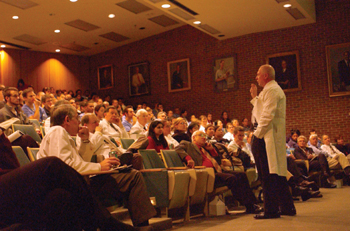
Vice Chancellor for Health Affairs Dr. Harry R. Jacobson spoke to medical students last week about reforming medical education. Anne Rayner
Jacobson speaks to medical students about reforming medical education, health care
If a biopsy were taken of the current health care situation in the United States, it would show that no one is really happy, Dr. Harry R. Jacobson told a large group of medical students last week at a speech on reforming medical education.
Patients are worried about quality and affordability of health care. Many employers are facing a crisis because they can’t afford the same health benefits for their employees that they are accustomed to providing. Caregivers are working in an environment where everyone is trying to control what they’re trying to do, and many hospitals have trouble controlling costs.
In 2001, the average operating margin of all the teaching hospitals in this country was a minus 1 percent, said Jacobson, vice chancellor for Health Affairs. And this year, $1.7 trillion will be spent on health care in the United States, or 14.3 percent of the gross domestic product.
People in the United States spend more than any other industrialized nation on health care and about 41 million Americans have no health insurance. The quality of health care is also often questionable, with about 100,000 deaths a year due to medical errors, as the Institute of Medicine recently pointed out in its report on medical errors.
“I’ve painted a pretty bleak picture, and it’s our job to figure out how medical education fits into all of this,” Jacobson told the group of medical students and faculty members who packed 208 Light Hall to hear his address.
There is also a residency program crisis with residents being limited to an 80-hour work week, creating a dilemma of how teaching hospitals deliver the same quality care and remain compliant with the resident working hours.
“When our residents work fewer hours the amount of work doesn’t go away, so other people have to do that work,” Jacobson said.
Resident work has been replaced in many circumstances by physician’s assistants and nurse practitioners hired to do the additional work, and just this year that has cost Vanderbilt University Hospital $2.6 million. If that could have been spent on medical education, the medical school could have offered scholarships to 74 medical students, he said.
But Jacobson said that’s not all bad news. “I happen to believe that we might learn something by using nurse practitioners and physician’s assistants more in the hospital setting.”
Jacobson said the Medical Center must decide whether to continue offering a community hospital experience for its residents who train in community hospitals, or bring the residents back to Vanderbilt to help contain costs.
There is also a tremendous gap between what physicians know works, as published in the medical literature, and what they actually do, and a huge practice variation based on where you live.
For example, in Redding, Calif., there are 12 coronary bypass surgeries per thousand people, and only three in Albuquerque, N.M. “Maybe there’s an epidemic of coronary artery disease in Redding, Calif. and all the healthy people live in Albuquerque,” Jacobson said, tongue-in-cheek.
“In many diseases you see a 300 to 400 percent variability in what is done,” he said. “What we need is the right information made available at the right time in the right setting,” Jacobson said.
Providing medical students with the vast amount of knowledge needed continues to be a challenge, Jacobson said. “If physicians went home and read two journal articles every day, at the end of the year they would only be 1,225 years behind. “We just can’t assimilate and retain all that information. It would be impossible.” There are more than 20,000 biomedical journals and 150,000 medical articles published each month and over 300,000 randomized controlled trials published on a regular basis. “That’s more information than anyone can possibly remember.”
Vanderbilt is ahead of the curve with a robust information technology program that helps both medical students and physicians keep the latest knowledge at their fingertips at all times.
“There should be standards of care that are widely shared based on peer-reviewed evidence, updated frequently, developed by expert panels, and taught to our medical students and in our wards and our clinics,” Jacobson said.
“The best doctors are the ones who know when they need information and how to get it. Evidence-based medicine is a very important component of the reforming of medical education,” Jacobson said, adding that a recent study shows that health care costs can be reduced by 26 percent if evidence-based medicine is used. “Half of the care delivered in this country today is not based on evidence,” he said.













